ACC621 Assignment: Comprehensive Analysis of Auditing Procedures
VerifiedAdded on 2023/06/03
|13
|2311
|242
Report
AI Summary
This report delves into the critical aspects of auditing, beginning with a preliminary assessment of materiality based on AASB 108 and ISA 320, calculating materiality levels for Feldsper Enterprise, and discussing the impact of materiality on audit budgets. It includes an analytical review using trend analysis of the income statement, followed by the identification of key accounts susceptible to material misstatement, such as sales, cost of goods sold (COGS), miscellaneous expenses, and wages, along with relevant assertions. The report outlines specific audit procedures for each identified account to detect potential misstatements. Finally, it addresses the auditor's role in fraud detection, emphasizing the importance of maintaining professional skepticism throughout the audit process. Desklib provides access to this document and a wealth of other solved assignments and study resources for students.
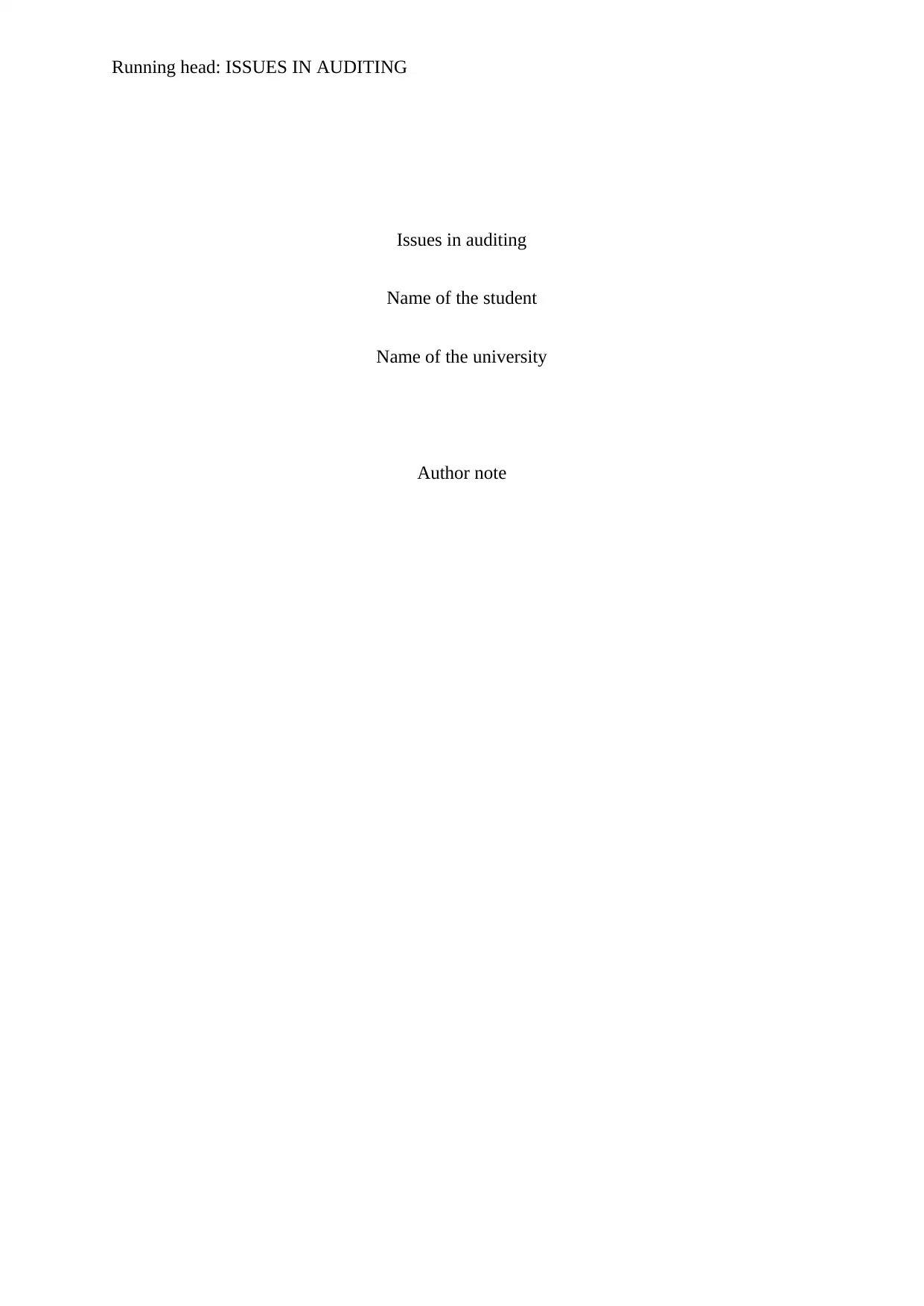
Running head: ISSUES IN AUDITING
Issues in auditing
Name of the student
Name of the university
Author note
Issues in auditing
Name of the student
Name of the university
Author note
Paraphrase This Document
Need a fresh take? Get an instant paraphrase of this document with our AI Paraphraser
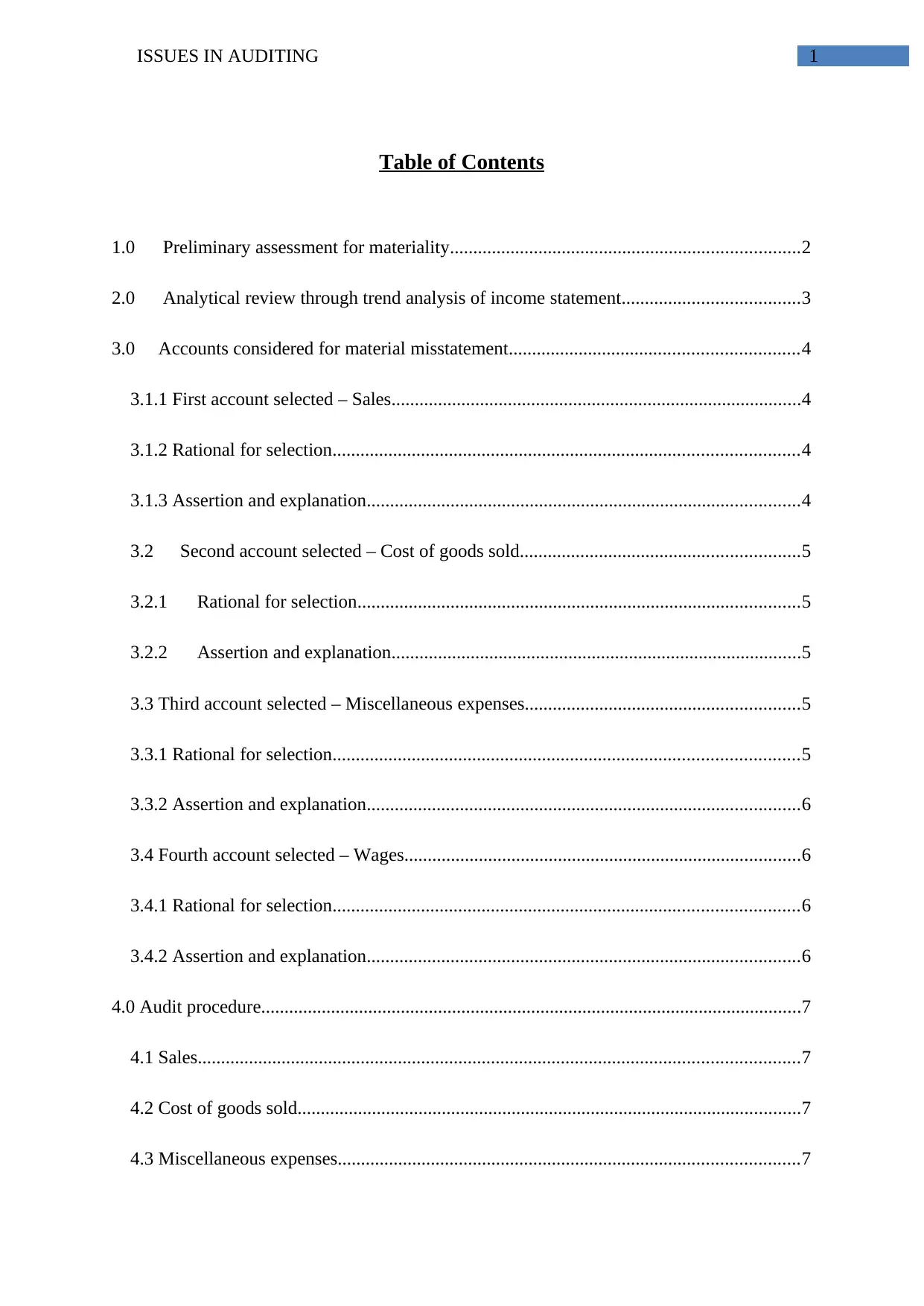
ISSUES IN AUDITING 1
Table of Contents
1.0 Preliminary assessment for materiality...........................................................................2
2.0 Analytical review through trend analysis of income statement......................................3
3.0 Accounts considered for material misstatement..............................................................4
3.1.1 First account selected – Sales........................................................................................4
3.1.2 Rational for selection....................................................................................................4
3.1.3 Assertion and explanation.............................................................................................4
3.2 Second account selected – Cost of goods sold............................................................5
3.2.1 Rational for selection...............................................................................................5
3.2.2 Assertion and explanation........................................................................................5
3.3 Third account selected – Miscellaneous expenses...........................................................5
3.3.1 Rational for selection....................................................................................................5
3.3.2 Assertion and explanation.............................................................................................6
3.4 Fourth account selected – Wages.....................................................................................6
3.4.1 Rational for selection....................................................................................................6
3.4.2 Assertion and explanation.............................................................................................6
4.0 Audit procedure....................................................................................................................7
4.1 Sales.................................................................................................................................7
4.2 Cost of goods sold............................................................................................................7
4.3 Miscellaneous expenses...................................................................................................7
Table of Contents
1.0 Preliminary assessment for materiality...........................................................................2
2.0 Analytical review through trend analysis of income statement......................................3
3.0 Accounts considered for material misstatement..............................................................4
3.1.1 First account selected – Sales........................................................................................4
3.1.2 Rational for selection....................................................................................................4
3.1.3 Assertion and explanation.............................................................................................4
3.2 Second account selected – Cost of goods sold............................................................5
3.2.1 Rational for selection...............................................................................................5
3.2.2 Assertion and explanation........................................................................................5
3.3 Third account selected – Miscellaneous expenses...........................................................5
3.3.1 Rational for selection....................................................................................................5
3.3.2 Assertion and explanation.............................................................................................6
3.4 Fourth account selected – Wages.....................................................................................6
3.4.1 Rational for selection....................................................................................................6
3.4.2 Assertion and explanation.............................................................................................6
4.0 Audit procedure....................................................................................................................7
4.1 Sales.................................................................................................................................7
4.2 Cost of goods sold............................................................................................................7
4.3 Miscellaneous expenses...................................................................................................7

ISSUES IN AUDITING 2
4.4 Wages...............................................................................................................................8
5.0 Fraud....................................................................................................................................8
Reference....................................................................................................................................9
4.4 Wages...............................................................................................................................8
5.0 Fraud....................................................................................................................................8
Reference....................................................................................................................................9
⊘ This is a preview!⊘
Do you want full access?
Subscribe today to unlock all pages.

Trusted by 1+ million students worldwide
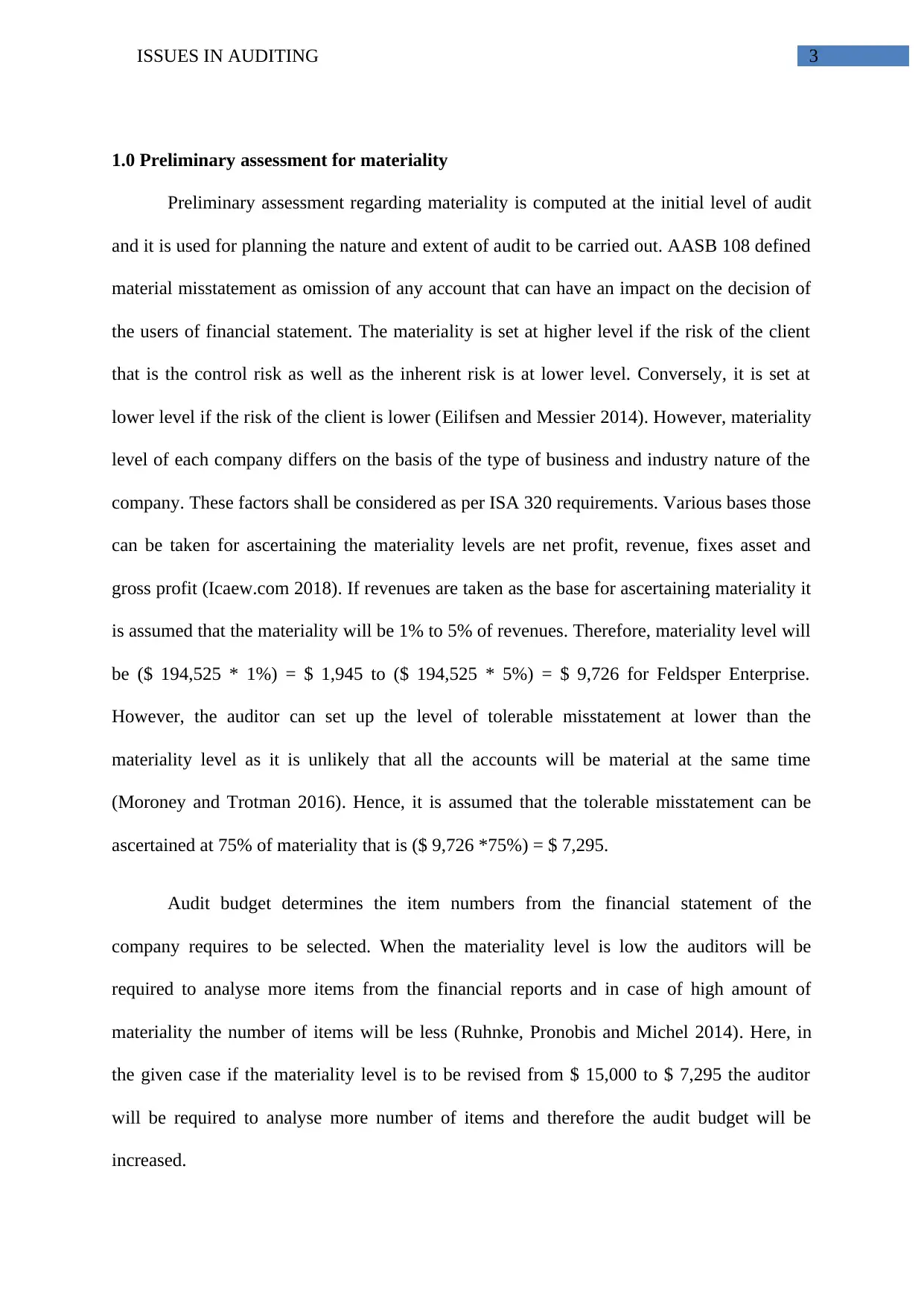
ISSUES IN AUDITING 3
1.0 Preliminary assessment for materiality
Preliminary assessment regarding materiality is computed at the initial level of audit
and it is used for planning the nature and extent of audit to be carried out. AASB 108 defined
material misstatement as omission of any account that can have an impact on the decision of
the users of financial statement. The materiality is set at higher level if the risk of the client
that is the control risk as well as the inherent risk is at lower level. Conversely, it is set at
lower level if the risk of the client is lower (Eilifsen and Messier 2014). However, materiality
level of each company differs on the basis of the type of business and industry nature of the
company. These factors shall be considered as per ISA 320 requirements. Various bases those
can be taken for ascertaining the materiality levels are net profit, revenue, fixes asset and
gross profit (Icaew.com 2018). If revenues are taken as the base for ascertaining materiality it
is assumed that the materiality will be 1% to 5% of revenues. Therefore, materiality level will
be ($ 194,525 * 1%) = $ 1,945 to ($ 194,525 * 5%) = $ 9,726 for Feldsper Enterprise.
However, the auditor can set up the level of tolerable misstatement at lower than the
materiality level as it is unlikely that all the accounts will be material at the same time
(Moroney and Trotman 2016). Hence, it is assumed that the tolerable misstatement can be
ascertained at 75% of materiality that is ($ 9,726 *75%) = $ 7,295.
Audit budget determines the item numbers from the financial statement of the
company requires to be selected. When the materiality level is low the auditors will be
required to analyse more items from the financial reports and in case of high amount of
materiality the number of items will be less (Ruhnke, Pronobis and Michel 2014). Here, in
the given case if the materiality level is to be revised from $ 15,000 to $ 7,295 the auditor
will be required to analyse more number of items and therefore the audit budget will be
increased.
1.0 Preliminary assessment for materiality
Preliminary assessment regarding materiality is computed at the initial level of audit
and it is used for planning the nature and extent of audit to be carried out. AASB 108 defined
material misstatement as omission of any account that can have an impact on the decision of
the users of financial statement. The materiality is set at higher level if the risk of the client
that is the control risk as well as the inherent risk is at lower level. Conversely, it is set at
lower level if the risk of the client is lower (Eilifsen and Messier 2014). However, materiality
level of each company differs on the basis of the type of business and industry nature of the
company. These factors shall be considered as per ISA 320 requirements. Various bases those
can be taken for ascertaining the materiality levels are net profit, revenue, fixes asset and
gross profit (Icaew.com 2018). If revenues are taken as the base for ascertaining materiality it
is assumed that the materiality will be 1% to 5% of revenues. Therefore, materiality level will
be ($ 194,525 * 1%) = $ 1,945 to ($ 194,525 * 5%) = $ 9,726 for Feldsper Enterprise.
However, the auditor can set up the level of tolerable misstatement at lower than the
materiality level as it is unlikely that all the accounts will be material at the same time
(Moroney and Trotman 2016). Hence, it is assumed that the tolerable misstatement can be
ascertained at 75% of materiality that is ($ 9,726 *75%) = $ 7,295.
Audit budget determines the item numbers from the financial statement of the
company requires to be selected. When the materiality level is low the auditors will be
required to analyse more items from the financial reports and in case of high amount of
materiality the number of items will be less (Ruhnke, Pronobis and Michel 2014). Here, in
the given case if the materiality level is to be revised from $ 15,000 to $ 7,295 the auditor
will be required to analyse more number of items and therefore the audit budget will be
increased.
Paraphrase This Document
Need a fresh take? Get an instant paraphrase of this document with our AI Paraphraser
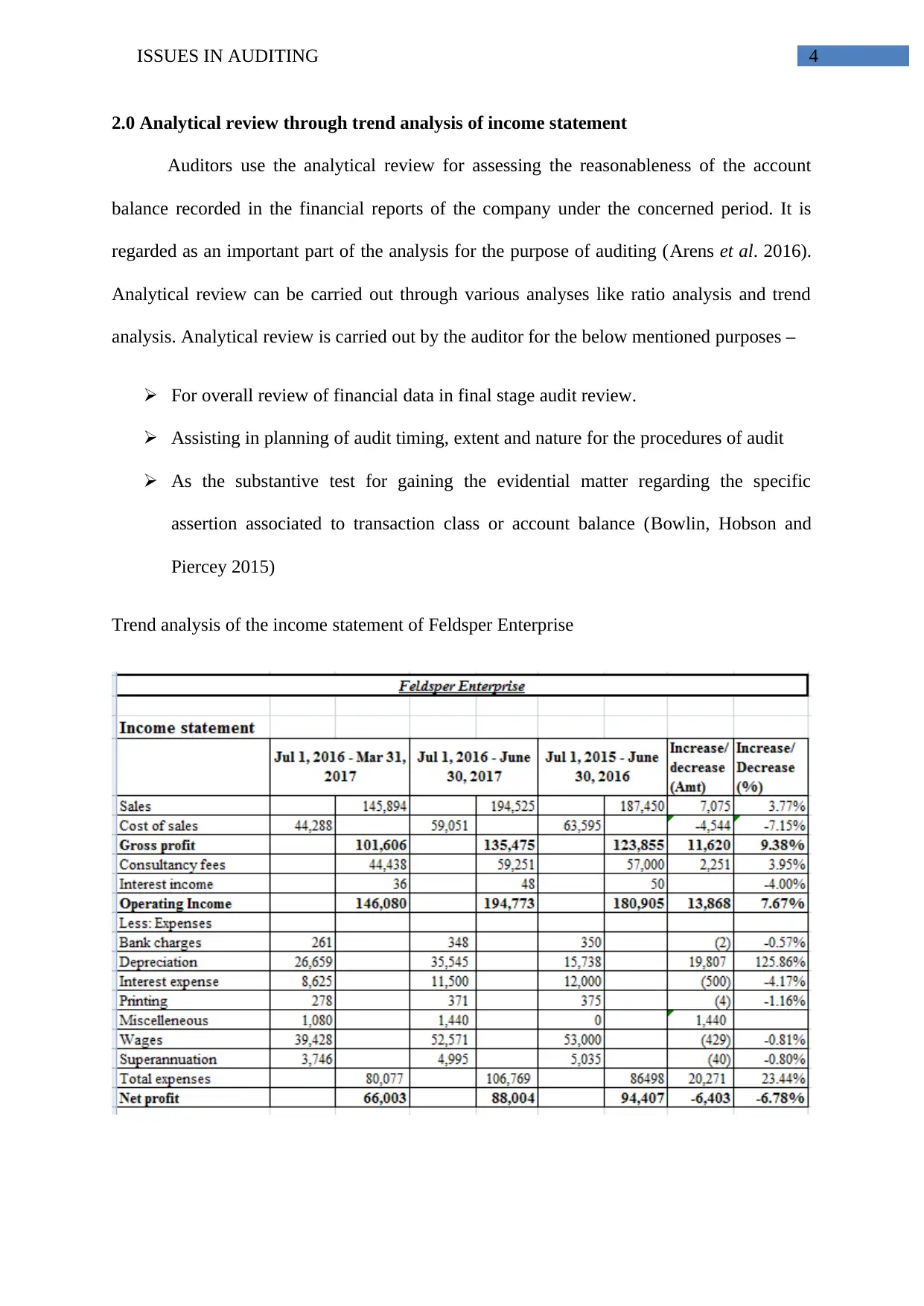
ISSUES IN AUDITING 4
2.0 Analytical review through trend analysis of income statement
Auditors use the analytical review for assessing the reasonableness of the account
balance recorded in the financial reports of the company under the concerned period. It is
regarded as an important part of the analysis for the purpose of auditing (Arens et al. 2016).
Analytical review can be carried out through various analyses like ratio analysis and trend
analysis. Analytical review is carried out by the auditor for the below mentioned purposes –
For overall review of financial data in final stage audit review.
Assisting in planning of audit timing, extent and nature for the procedures of audit
As the substantive test for gaining the evidential matter regarding the specific
assertion associated to transaction class or account balance (Bowlin, Hobson and
Piercey 2015)
Trend analysis of the income statement of Feldsper Enterprise
2.0 Analytical review through trend analysis of income statement
Auditors use the analytical review for assessing the reasonableness of the account
balance recorded in the financial reports of the company under the concerned period. It is
regarded as an important part of the analysis for the purpose of auditing (Arens et al. 2016).
Analytical review can be carried out through various analyses like ratio analysis and trend
analysis. Analytical review is carried out by the auditor for the below mentioned purposes –
For overall review of financial data in final stage audit review.
Assisting in planning of audit timing, extent and nature for the procedures of audit
As the substantive test for gaining the evidential matter regarding the specific
assertion associated to transaction class or account balance (Bowlin, Hobson and
Piercey 2015)
Trend analysis of the income statement of Feldsper Enterprise
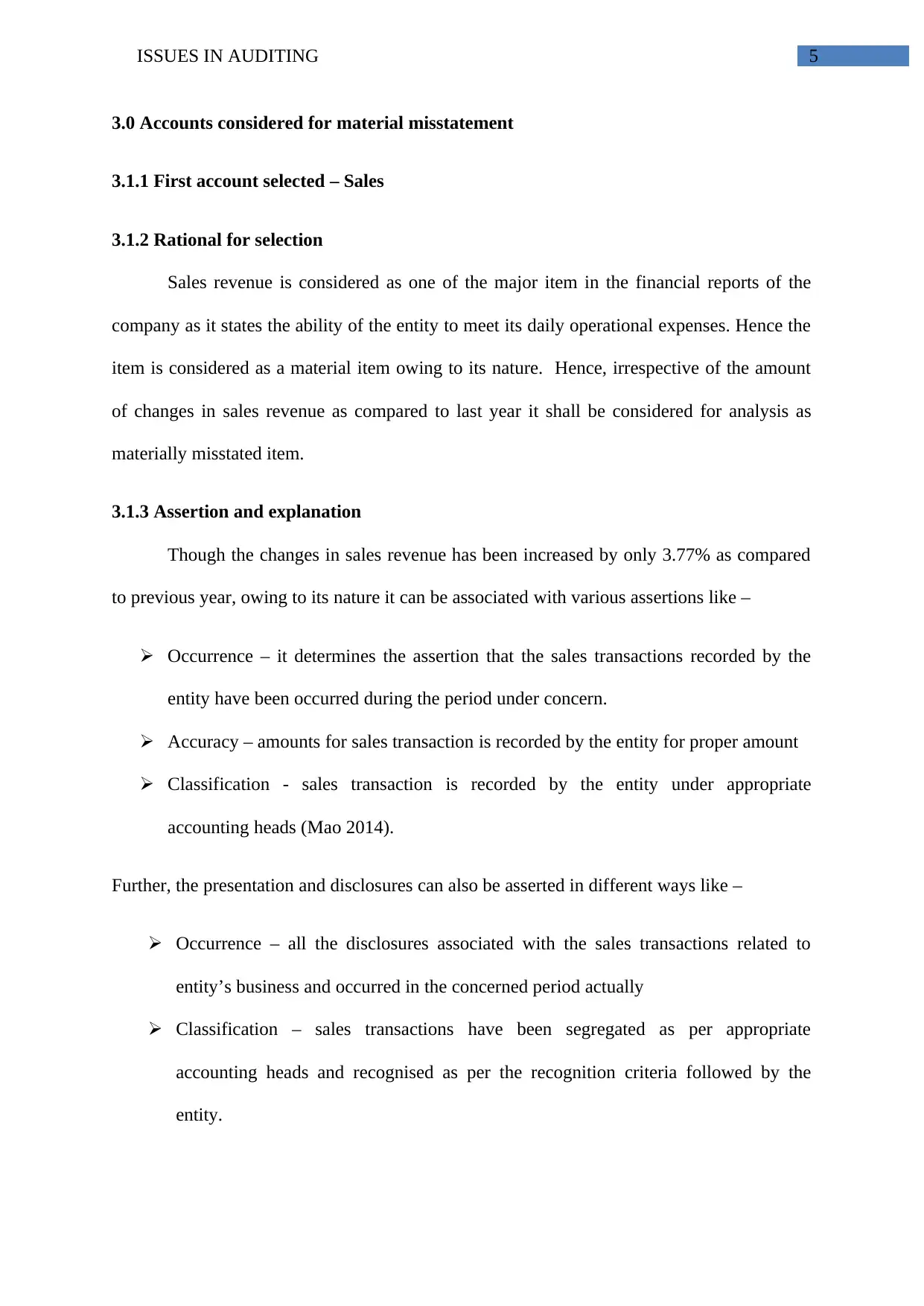
ISSUES IN AUDITING 5
3.0 Accounts considered for material misstatement
3.1.1 First account selected – Sales
3.1.2 Rational for selection
Sales revenue is considered as one of the major item in the financial reports of the
company as it states the ability of the entity to meet its daily operational expenses. Hence the
item is considered as a material item owing to its nature. Hence, irrespective of the amount
of changes in sales revenue as compared to last year it shall be considered for analysis as
materially misstated item.
3.1.3 Assertion and explanation
Though the changes in sales revenue has been increased by only 3.77% as compared
to previous year, owing to its nature it can be associated with various assertions like –
Occurrence – it determines the assertion that the sales transactions recorded by the
entity have been occurred during the period under concern.
Accuracy – amounts for sales transaction is recorded by the entity for proper amount
Classification - sales transaction is recorded by the entity under appropriate
accounting heads (Mao 2014).
Further, the presentation and disclosures can also be asserted in different ways like –
Occurrence – all the disclosures associated with the sales transactions related to
entity’s business and occurred in the concerned period actually
Classification – sales transactions have been segregated as per appropriate
accounting heads and recognised as per the recognition criteria followed by the
entity.
3.0 Accounts considered for material misstatement
3.1.1 First account selected – Sales
3.1.2 Rational for selection
Sales revenue is considered as one of the major item in the financial reports of the
company as it states the ability of the entity to meet its daily operational expenses. Hence the
item is considered as a material item owing to its nature. Hence, irrespective of the amount
of changes in sales revenue as compared to last year it shall be considered for analysis as
materially misstated item.
3.1.3 Assertion and explanation
Though the changes in sales revenue has been increased by only 3.77% as compared
to previous year, owing to its nature it can be associated with various assertions like –
Occurrence – it determines the assertion that the sales transactions recorded by the
entity have been occurred during the period under concern.
Accuracy – amounts for sales transaction is recorded by the entity for proper amount
Classification - sales transaction is recorded by the entity under appropriate
accounting heads (Mao 2014).
Further, the presentation and disclosures can also be asserted in different ways like –
Occurrence – all the disclosures associated with the sales transactions related to
entity’s business and occurred in the concerned period actually
Classification – sales transactions have been segregated as per appropriate
accounting heads and recognised as per the recognition criteria followed by the
entity.
⊘ This is a preview!⊘
Do you want full access?
Subscribe today to unlock all pages.

Trusted by 1+ million students worldwide

ISSUES IN AUDITING 6
3.2 Second account selected – Cost of goods sold
3.2.1 Rational for selection
As large amount of saes revenue is eaten up by COGS this item shall be considered as
material owing to its nature. As COGS includes the expenses for various heads like labour
expenses, cost of material purchases and overhead expenses, it leaves wide scope to the
management to misstate it if it prefers to show that the company is left with sufficient amount
for paying off its operational expenses.
3.2.2 Assertion and explanation
The changes in COGS have been noticed that it reduced by 7.15% as compared to
previous year that states the entity was able to reduce the costs. However, at the same time it
may point out that the management may has misstated the amount to show that the company
sufficient amount for paying off its operational expenses. Different assertions linked with the
item may be as follows –
Accuracy – amounts for COGS is recorded by the entity for proper amount
Occurrence – it determines the assertion that the COGS recorded by the entity have
been occurred during the period under concern (Louwers et al. 2015).
Classification - COGS is recorded by the entity under appropriate accounting heads.
3.3 Third account selected – Miscellaneous expenses
3.3.1 Rational for selection
From the provided trial balance of Feldsper Enterprise it can be identified that the
miscellaneous expenses of the entity for the current year amounted to 1,440. However, there
were no such expenses recorded for the previous accounting year. It is likely that the
3.2 Second account selected – Cost of goods sold
3.2.1 Rational for selection
As large amount of saes revenue is eaten up by COGS this item shall be considered as
material owing to its nature. As COGS includes the expenses for various heads like labour
expenses, cost of material purchases and overhead expenses, it leaves wide scope to the
management to misstate it if it prefers to show that the company is left with sufficient amount
for paying off its operational expenses.
3.2.2 Assertion and explanation
The changes in COGS have been noticed that it reduced by 7.15% as compared to
previous year that states the entity was able to reduce the costs. However, at the same time it
may point out that the management may has misstated the amount to show that the company
sufficient amount for paying off its operational expenses. Different assertions linked with the
item may be as follows –
Accuracy – amounts for COGS is recorded by the entity for proper amount
Occurrence – it determines the assertion that the COGS recorded by the entity have
been occurred during the period under concern (Louwers et al. 2015).
Classification - COGS is recorded by the entity under appropriate accounting heads.
3.3 Third account selected – Miscellaneous expenses
3.3.1 Rational for selection
From the provided trial balance of Feldsper Enterprise it can be identified that the
miscellaneous expenses of the entity for the current year amounted to 1,440. However, there
were no such expenses recorded for the previous accounting year. It is likely that the
Paraphrase This Document
Need a fresh take? Get an instant paraphrase of this document with our AI Paraphraser
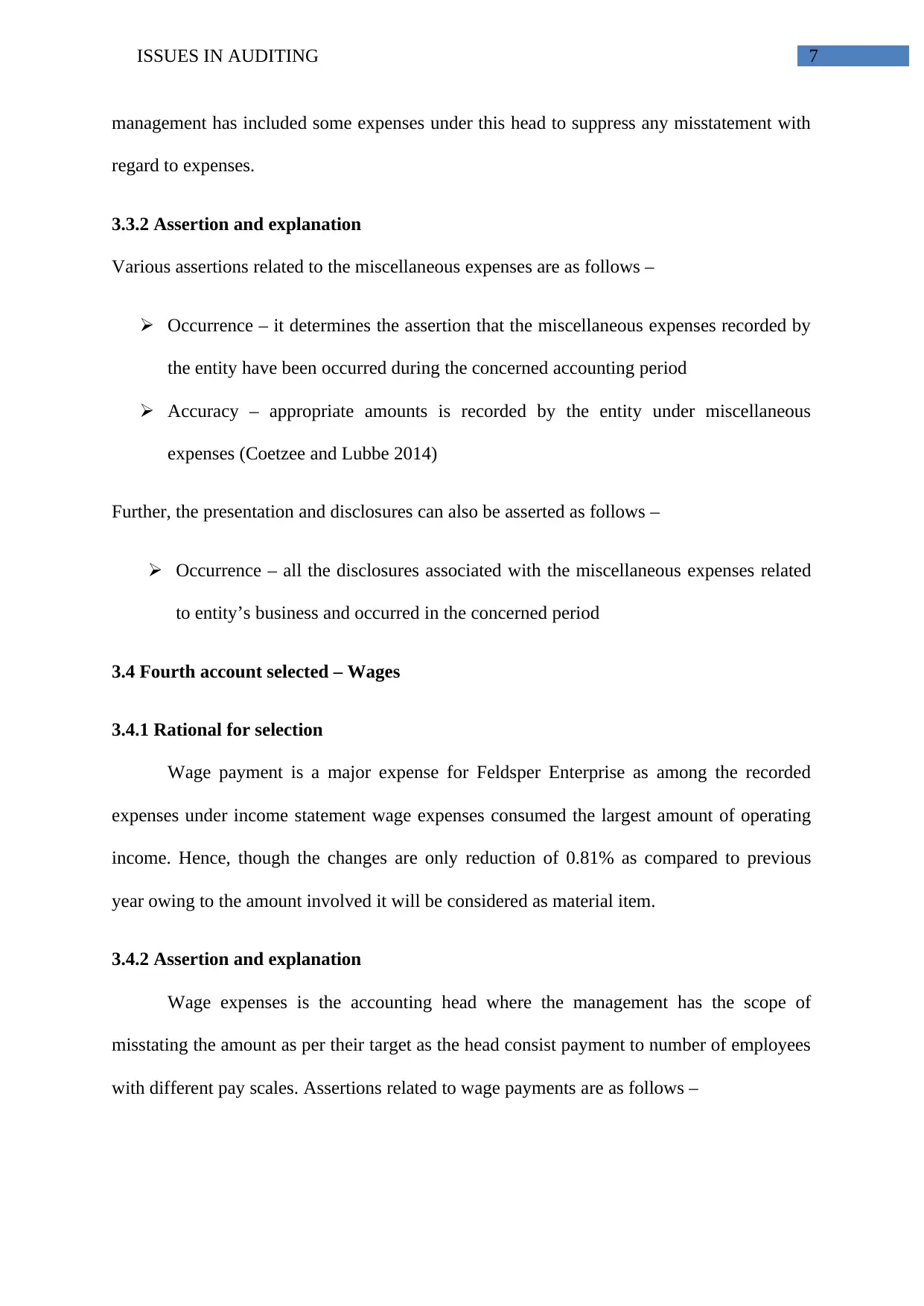
ISSUES IN AUDITING 7
management has included some expenses under this head to suppress any misstatement with
regard to expenses.
3.3.2 Assertion and explanation
Various assertions related to the miscellaneous expenses are as follows –
Occurrence – it determines the assertion that the miscellaneous expenses recorded by
the entity have been occurred during the concerned accounting period
Accuracy – appropriate amounts is recorded by the entity under miscellaneous
expenses (Coetzee and Lubbe 2014)
Further, the presentation and disclosures can also be asserted as follows –
Occurrence – all the disclosures associated with the miscellaneous expenses related
to entity’s business and occurred in the concerned period
3.4 Fourth account selected – Wages
3.4.1 Rational for selection
Wage payment is a major expense for Feldsper Enterprise as among the recorded
expenses under income statement wage expenses consumed the largest amount of operating
income. Hence, though the changes are only reduction of 0.81% as compared to previous
year owing to the amount involved it will be considered as material item.
3.4.2 Assertion and explanation
Wage expenses is the accounting head where the management has the scope of
misstating the amount as per their target as the head consist payment to number of employees
with different pay scales. Assertions related to wage payments are as follows –
management has included some expenses under this head to suppress any misstatement with
regard to expenses.
3.3.2 Assertion and explanation
Various assertions related to the miscellaneous expenses are as follows –
Occurrence – it determines the assertion that the miscellaneous expenses recorded by
the entity have been occurred during the concerned accounting period
Accuracy – appropriate amounts is recorded by the entity under miscellaneous
expenses (Coetzee and Lubbe 2014)
Further, the presentation and disclosures can also be asserted as follows –
Occurrence – all the disclosures associated with the miscellaneous expenses related
to entity’s business and occurred in the concerned period
3.4 Fourth account selected – Wages
3.4.1 Rational for selection
Wage payment is a major expense for Feldsper Enterprise as among the recorded
expenses under income statement wage expenses consumed the largest amount of operating
income. Hence, though the changes are only reduction of 0.81% as compared to previous
year owing to the amount involved it will be considered as material item.
3.4.2 Assertion and explanation
Wage expenses is the accounting head where the management has the scope of
misstating the amount as per their target as the head consist payment to number of employees
with different pay scales. Assertions related to wage payments are as follows –
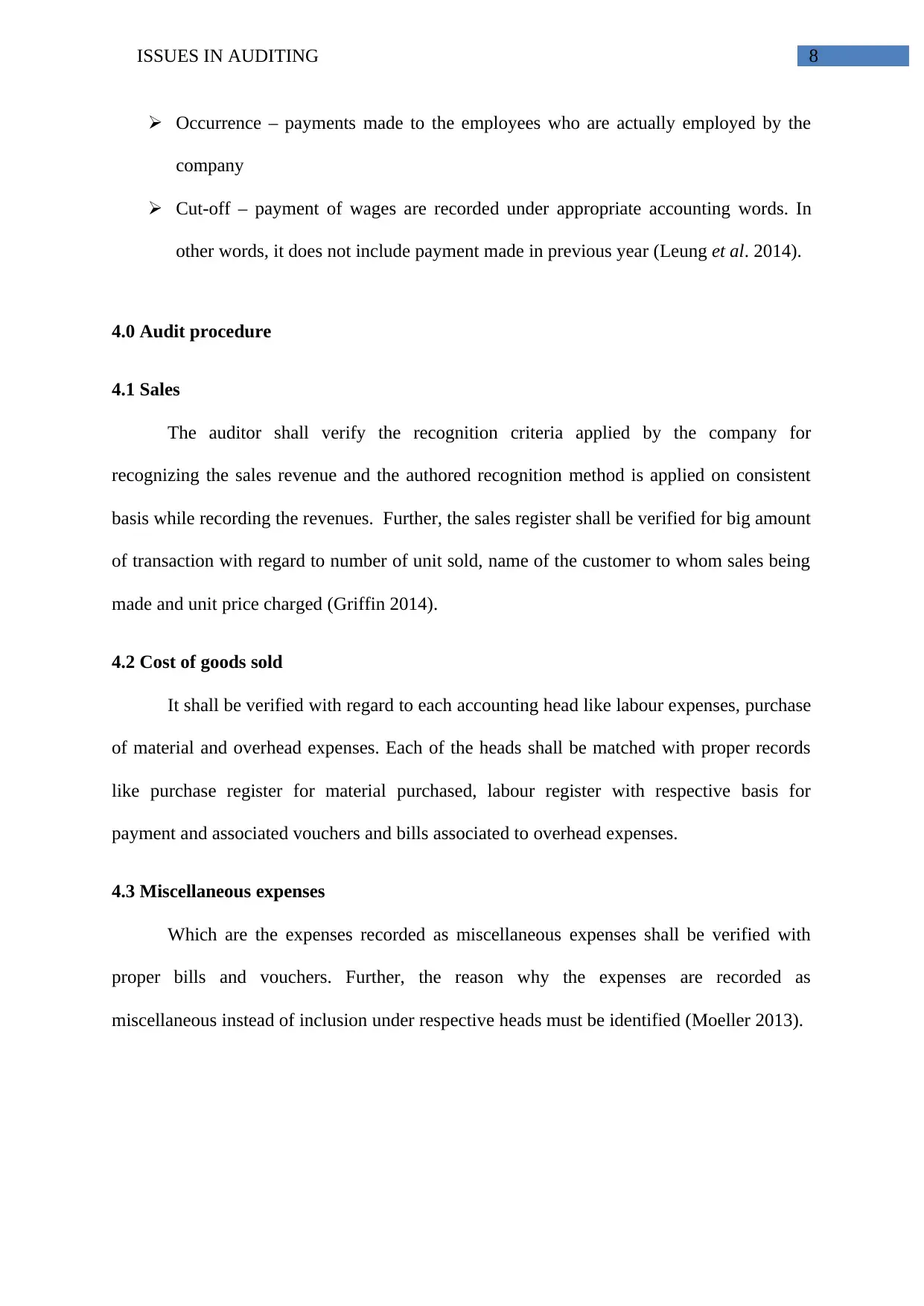
ISSUES IN AUDITING 8
Occurrence – payments made to the employees who are actually employed by the
company
Cut-off – payment of wages are recorded under appropriate accounting words. In
other words, it does not include payment made in previous year (Leung et al. 2014).
4.0 Audit procedure
4.1 Sales
The auditor shall verify the recognition criteria applied by the company for
recognizing the sales revenue and the authored recognition method is applied on consistent
basis while recording the revenues. Further, the sales register shall be verified for big amount
of transaction with regard to number of unit sold, name of the customer to whom sales being
made and unit price charged (Griffin 2014).
4.2 Cost of goods sold
It shall be verified with regard to each accounting head like labour expenses, purchase
of material and overhead expenses. Each of the heads shall be matched with proper records
like purchase register for material purchased, labour register with respective basis for
payment and associated vouchers and bills associated to overhead expenses.
4.3 Miscellaneous expenses
Which are the expenses recorded as miscellaneous expenses shall be verified with
proper bills and vouchers. Further, the reason why the expenses are recorded as
miscellaneous instead of inclusion under respective heads must be identified (Moeller 2013).
Occurrence – payments made to the employees who are actually employed by the
company
Cut-off – payment of wages are recorded under appropriate accounting words. In
other words, it does not include payment made in previous year (Leung et al. 2014).
4.0 Audit procedure
4.1 Sales
The auditor shall verify the recognition criteria applied by the company for
recognizing the sales revenue and the authored recognition method is applied on consistent
basis while recording the revenues. Further, the sales register shall be verified for big amount
of transaction with regard to number of unit sold, name of the customer to whom sales being
made and unit price charged (Griffin 2014).
4.2 Cost of goods sold
It shall be verified with regard to each accounting head like labour expenses, purchase
of material and overhead expenses. Each of the heads shall be matched with proper records
like purchase register for material purchased, labour register with respective basis for
payment and associated vouchers and bills associated to overhead expenses.
4.3 Miscellaneous expenses
Which are the expenses recorded as miscellaneous expenses shall be verified with
proper bills and vouchers. Further, the reason why the expenses are recorded as
miscellaneous instead of inclusion under respective heads must be identified (Moeller 2013).
⊘ This is a preview!⊘
Do you want full access?
Subscribe today to unlock all pages.

Trusted by 1+ million students worldwide
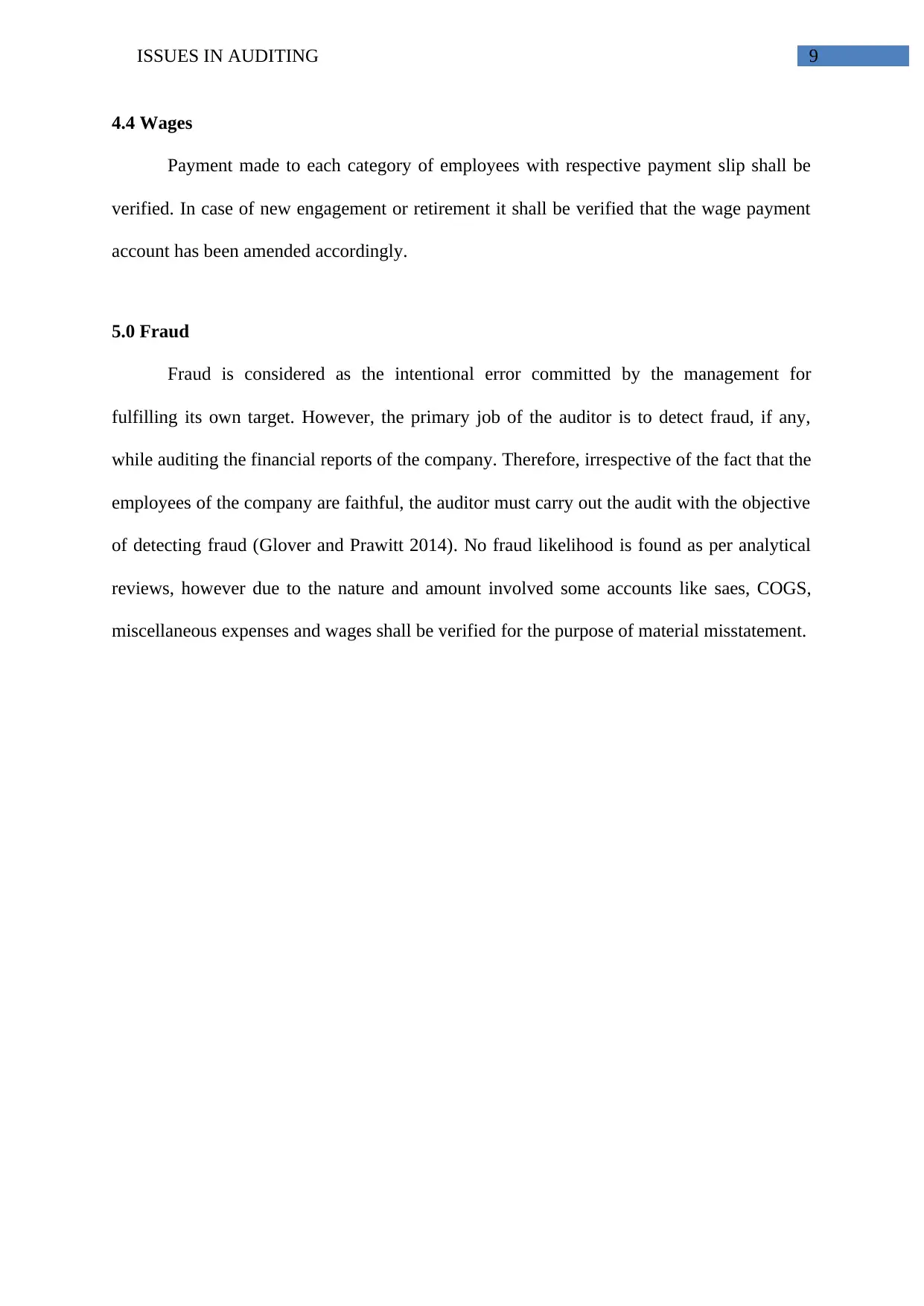
ISSUES IN AUDITING 9
4.4 Wages
Payment made to each category of employees with respective payment slip shall be
verified. In case of new engagement or retirement it shall be verified that the wage payment
account has been amended accordingly.
5.0 Fraud
Fraud is considered as the intentional error committed by the management for
fulfilling its own target. However, the primary job of the auditor is to detect fraud, if any,
while auditing the financial reports of the company. Therefore, irrespective of the fact that the
employees of the company are faithful, the auditor must carry out the audit with the objective
of detecting fraud (Glover and Prawitt 2014). No fraud likelihood is found as per analytical
reviews, however due to the nature and amount involved some accounts like saes, COGS,
miscellaneous expenses and wages shall be verified for the purpose of material misstatement.
4.4 Wages
Payment made to each category of employees with respective payment slip shall be
verified. In case of new engagement or retirement it shall be verified that the wage payment
account has been amended accordingly.
5.0 Fraud
Fraud is considered as the intentional error committed by the management for
fulfilling its own target. However, the primary job of the auditor is to detect fraud, if any,
while auditing the financial reports of the company. Therefore, irrespective of the fact that the
employees of the company are faithful, the auditor must carry out the audit with the objective
of detecting fraud (Glover and Prawitt 2014). No fraud likelihood is found as per analytical
reviews, however due to the nature and amount involved some accounts like saes, COGS,
miscellaneous expenses and wages shall be verified for the purpose of material misstatement.
Paraphrase This Document
Need a fresh take? Get an instant paraphrase of this document with our AI Paraphraser
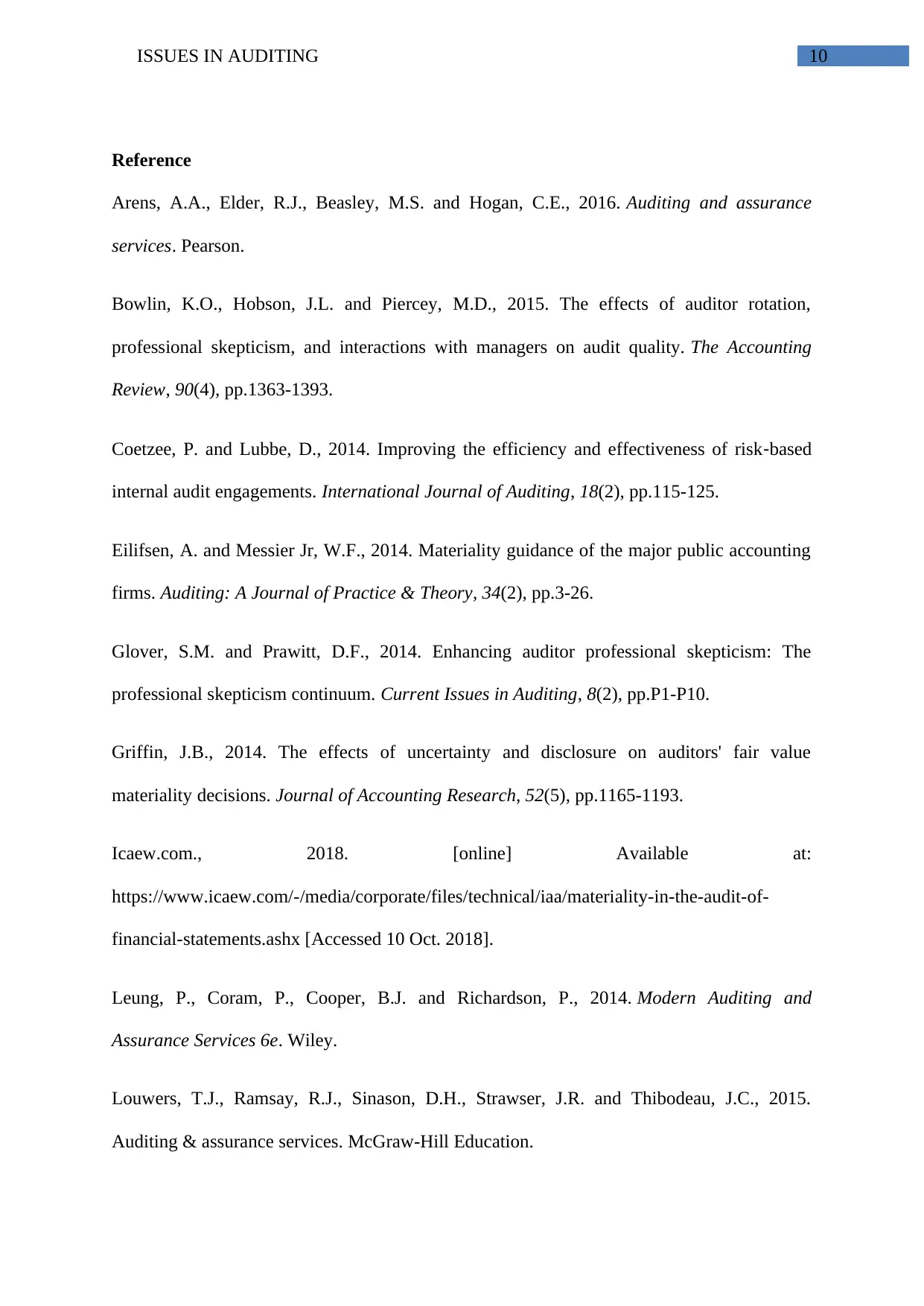
ISSUES IN AUDITING 10
Reference
Arens, A.A., Elder, R.J., Beasley, M.S. and Hogan, C.E., 2016. Auditing and assurance
services. Pearson.
Bowlin, K.O., Hobson, J.L. and Piercey, M.D., 2015. The effects of auditor rotation,
professional skepticism, and interactions with managers on audit quality. The Accounting
Review, 90(4), pp.1363-1393.
Coetzee, P. and Lubbe, D., 2014. Improving the efficiency and effectiveness of risk‐based
internal audit engagements. International Journal of Auditing, 18(2), pp.115-125.
Eilifsen, A. and Messier Jr, W.F., 2014. Materiality guidance of the major public accounting
firms. Auditing: A Journal of Practice & Theory, 34(2), pp.3-26.
Glover, S.M. and Prawitt, D.F., 2014. Enhancing auditor professional skepticism: The
professional skepticism continuum. Current Issues in Auditing, 8(2), pp.P1-P10.
Griffin, J.B., 2014. The effects of uncertainty and disclosure on auditors' fair value
materiality decisions. Journal of Accounting Research, 52(5), pp.1165-1193.
Icaew.com., 2018. [online] Available at:
https://www.icaew.com/-/media/corporate/files/technical/iaa/materiality-in-the-audit-of-
financial-statements.ashx [Accessed 10 Oct. 2018].
Leung, P., Coram, P., Cooper, B.J. and Richardson, P., 2014. Modern Auditing and
Assurance Services 6e. Wiley.
Louwers, T.J., Ramsay, R.J., Sinason, D.H., Strawser, J.R. and Thibodeau, J.C., 2015.
Auditing & assurance services. McGraw-Hill Education.
Reference
Arens, A.A., Elder, R.J., Beasley, M.S. and Hogan, C.E., 2016. Auditing and assurance
services. Pearson.
Bowlin, K.O., Hobson, J.L. and Piercey, M.D., 2015. The effects of auditor rotation,
professional skepticism, and interactions with managers on audit quality. The Accounting
Review, 90(4), pp.1363-1393.
Coetzee, P. and Lubbe, D., 2014. Improving the efficiency and effectiveness of risk‐based
internal audit engagements. International Journal of Auditing, 18(2), pp.115-125.
Eilifsen, A. and Messier Jr, W.F., 2014. Materiality guidance of the major public accounting
firms. Auditing: A Journal of Practice & Theory, 34(2), pp.3-26.
Glover, S.M. and Prawitt, D.F., 2014. Enhancing auditor professional skepticism: The
professional skepticism continuum. Current Issues in Auditing, 8(2), pp.P1-P10.
Griffin, J.B., 2014. The effects of uncertainty and disclosure on auditors' fair value
materiality decisions. Journal of Accounting Research, 52(5), pp.1165-1193.
Icaew.com., 2018. [online] Available at:
https://www.icaew.com/-/media/corporate/files/technical/iaa/materiality-in-the-audit-of-
financial-statements.ashx [Accessed 10 Oct. 2018].
Leung, P., Coram, P., Cooper, B.J. and Richardson, P., 2014. Modern Auditing and
Assurance Services 6e. Wiley.
Louwers, T.J., Ramsay, R.J., Sinason, D.H., Strawser, J.R. and Thibodeau, J.C., 2015.
Auditing & assurance services. McGraw-Hill Education.

ISSUES IN AUDITING 11
Mao, M., 2014, June. Experimental Methods of Materiality Judgment on Auditor’s
Experience and Performance. In 3rd International Conference on Science and Social
Research (ICSSR 2014). Atlantis Press.
Moeller, R.R., 2013. Role of Internal Audit in Enterprise Risk Management. COSO
Enterprise Risk Management: Establishing Effective Governance, Risk, and Compliance
Processes, Second Edition, pp.247-266.
Moroney, R. and Trotman, K.T., 2016. Differences in Auditors' Materiality Assessments
When Auditing Financial Statements and Sustainability Reports. Contemporary Accounting
Research, 33(2), pp.551-575.
Ruhnke, K., Pronobis, P. and Michel, M., 2014. Audit materiality disclosures and credit
lending decisions.
Mao, M., 2014, June. Experimental Methods of Materiality Judgment on Auditor’s
Experience and Performance. In 3rd International Conference on Science and Social
Research (ICSSR 2014). Atlantis Press.
Moeller, R.R., 2013. Role of Internal Audit in Enterprise Risk Management. COSO
Enterprise Risk Management: Establishing Effective Governance, Risk, and Compliance
Processes, Second Edition, pp.247-266.
Moroney, R. and Trotman, K.T., 2016. Differences in Auditors' Materiality Assessments
When Auditing Financial Statements and Sustainability Reports. Contemporary Accounting
Research, 33(2), pp.551-575.
Ruhnke, K., Pronobis, P. and Michel, M., 2014. Audit materiality disclosures and credit
lending decisions.
⊘ This is a preview!⊘
Do you want full access?
Subscribe today to unlock all pages.

Trusted by 1+ million students worldwide
1 out of 13
Related Documents
Your All-in-One AI-Powered Toolkit for Academic Success.
+13062052269
info@desklib.com
Available 24*7 on WhatsApp / Email
![[object Object]](/_next/static/media/star-bottom.7253800d.svg)
Unlock your academic potential
Copyright © 2020–2025 A2Z Services. All Rights Reserved. Developed and managed by ZUCOL.

